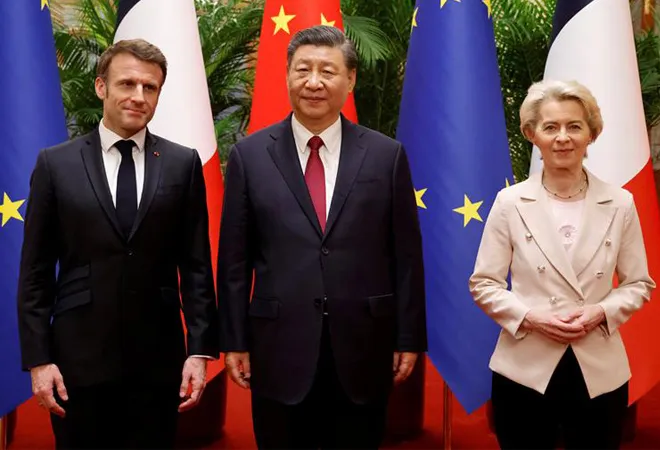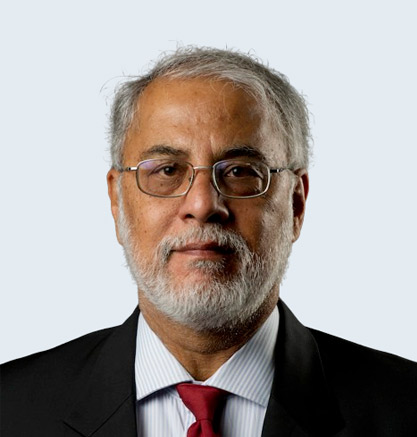-
CENTRES
Progammes & Centres
Location
Has growing US-Europe ties after the Ukraine crisis impacted EU interests in China?

French President Emmanuel Macron and European Commission President Ursula von der Leyen visited Beijing for a summit with President Xi Jinping of China between 5-7 April. Their joint trip was aimed at engaging China, while signalling to their hosts that the European Union (EU) would work as a team.
The visit is a part of a noticeable push by Europe to maintain an even keel in their ties with China, which have been roiled by the events in Ukraine, issues relating to human rights in Xinjiang, and the pulls generated by the US-China tensions. In recent months, Beijing has seen visits by German Chancellor Olaf Scholz and Spanish Prime Minister Pedro Sanchez.
The visit is a part of a noticeable push by Europe to maintain an even keel in their ties with China, which have been roiled by the events in Ukraine, issues relating to human rights in Xinjiang, and the pulls generated by the US-China tensions.
Ursula von der Leyen was in Beijing at the invitation of President Macron and there was a sharp contrast in the way the Chinese handled their respective visits. While the French President got the full red-carpet treatment, von der Leyen was clearly given the cold shoulder. This was occasioned no doubt by the strong relationship that President Joe Biden has struck with von der Leyen since the beginning of the Ukraine conflict.
For its part, China has been keen to engage Europe at a time when its ties with the United States (US) are hitting rock bottom and where there has been a marked suspicion of China’s actions in relation to the Ukraine crisis. Earlier this year, China’s top diplomat Wang Yi toured Europe, gave a speech at the Munich Security Conference where he presented China’s 12-point peace plan for Ukraine and sought to send a message to the US in the wake of the spy balloon issue.
On the eve of her Beijing visit, von der Leyen gave a tough speech at a think tank criticising Xi for maintaining ties of friendship with Putin. Referring to the Chinese peace proposal, she added that any plan that did not address the annexation of Ukrainian territory was not viable. However, she accepted that decoupling was not a viable strategy for Europe, though there was a need for “diplomatic and economic de-risking.” And as part of this strategy, the EU should not hesitate to raise uncomfortable issues with the Chinese while, at the same time, adopting policies that would make the EU economy and industry more competitive and resilient.
The two European leaders met President Xi bilaterally, as well as in a trilateral meeting on 6 April. Ahead of the meeting, standing alongside Xi, Macron said he was counting on China “to bring Russia back to reason and everyone back to the negotiating table,” on Ukraine. Following the meeting with Macron, Xi reaffirmed China’s commitment towards facilitating peace talks and a political settlement of the Ukraine crisis and said that China was ready to issue a joint call with France for the purpose. Significantly, his statement added that besides the need to protect civilians, “nuclear weapons must not be used, and nuclear war must not be fought.” In calling for the resumption of peace talks, the statement noted that they should “accommodate the legitimate security interests of all parties, seek political settlement and foster a balanced, effective and sustainable European security architecture.”
A Chinese readout of the Xi-von der Leyen meeting saw Xi emphasising the role of the EU as a strategic force in the international situation. He said that “China and the EU should face up to differences, manage them and respect each other.” For her part, von der Leyen noted that there was a great deal of consensus between the two parties on issues like climate change and political settlement of regional disputes. She noted that the Europeans did not accept the notion of “decoupling” and hoped to restart their stalled dialogue with China.
Differences over the Ukraine conflict
But at a press conference she addressed later in the evening at the EU office, von der Leyen warned China against aiding the Russian war effort saying, “this would indeed significantly harm the relationship between the European Union and China.” However, she did note that China had a crucial role and that the EU expected it “to play its role and promote just peace, one that respects Ukraine’s territorial integrity.”
But besides ringing declarations and nice-sounding words, little of practical value seems to have been achieved as far as Ukraine is concerned. There is no discernible shift in the positions that Xi took in relation to China’s position on the Ukraine conflict.
As it is, expectations that President Xi would speak telephonically to President Zelensky of Ukraine after his recent Russia visit have been belied. Von der Leyen did say that she had raised the issue with Xi and his response was that he would be willing to speak when “conditions and the time are ripe.”
The Chinese readout of the trilateral meeting suggested that Chinese aims with regards to Europe are for Europe to maintain its strategic autonomy, enhance supply chain security, and avoid decoupling. It noted Xi as saying that the “China-EU relationship does not target any third party, nor should it be dependent on or dictated by any third party.” He attacked those who sought to play up the “democracy vs authoritarianism” narrative that was stoking a new Cold War.
On Wednesday, in an interview, China’s Ambassador to the European Union, Fu Cong, said that the Russian-Chinese joint statement on the eve of the Ukraine conflict in February 2022, declaring that there were “no limits” to their ties, has been misrepresented and that the ‘no limit’ ties are nothing but rhetoric.” Fu’s remarks were aimed at countering von der Leyen’s remarks.
Other significant differences between the EU and China
Besides China’s stand on Ukraine, there are also other issues that divide the two. A major one is the treatment of Uighurs in Xinjiang, which led to EU sanctions on some Chinese officials and entities in 2021, with Beijing responding with sanctions against members of the European parliament. A major EU-China investment agreement has since remained in limbo. Neither are the Europeans happy about Beijing’s sanctions on Lithuania for allowing Taiwan to open a representation office.
China and the EU have significant trade ties; China was the third largest destination of EU exports in 2022 and the largest exporter to the EU. The recent statements in Beijing suggested that both sides see the benefit to themselves in maintaining a cooperative relationship with each other. Just how useful the relationship could be was apparent from the several deals discussed and signed by France and China involving billions of euros during the visit, including the sale of 160 Airbus passenger aircraft, many of which will be made in a new assembly line in Airbus’ factory in Tianjin.
But the larger set of differences arise from the changed perceptions of China in the US and Europe. In 2017, the US National Security Strategy declared China to be a “strategic competitor.” Two years later, in 2019, the European Commissioners adopted a joint communication that termed China a “an economic competitor in pursuit of technological leadership and a systemic rival promoting alternative models of governance.” Today, the EU is grappling with just what “systemic rival” means.
The China of today presents a significant political challenge to the EU through its decision to back Russia. Just what the “no limits” partnership implied was evident in Xi’s farewell remarks to Putin after the former’s visit to Moscow last month: “Right now there are changes, the likes of which we have not seen for 100 years. And we are the ones driving these changes together.”
The China-EEurope and ChinaU dynamic was clearly visible in the visit. Where the EU sought to present a united front, the Chinese played favourites by giving Macron the red-carpet treatment, while playing down von der Leyen. Chinese strategy in Europe has been to play up differences between the 27 member countries. Wang Yi’s February tour, for example saw him visit France, Germany, Italy, and Hungary, countries that are perceived to be friendlier to Beijing.
There are concerns in some European circles that the grouping may be over-reacting and the result could impact EU interests in China. But on the other hand, the EU and the US have worked hard to put their differences aside and apply themselves unitedly to assist Ukraine.
In the recent past, China has promoted the China and Central and Eastern European Countries (CEEC) grouping also known at various times as the 16+1 and the 17+1 grouping. But this has foundered over the Lithuanian issue, and now the Ukraine conflict where Chinese policy has generated considerable unease, especially in Eastern Europe.
In all this, the issue for Europe is whether it has lost some of its strategic autonomy by drawing too close to the US since the Ukraine conflict. There are concerns in some European circles that the grouping may be over-reacting and the result could impact EU interests in China. But on the other hand, the EU and the US have worked hard to put their differences aside and apply themselves unitedly to assist Ukraine. While a revitalised NATO is dealing with the security front, the new US-EU Trade and Technology Council is seeking to create a new framework to promote digital infrastructure and connectivity, cooperation on emerging technologies, resilient semiconductor supply chains, and enhancing their security through export controls and investment screening.
The views expressed above belong to the author(s). ORF research and analyses now available on Telegram! Click here to access our curated content — blogs, longforms and interviews.

Manoj Joshi is a Distinguished Fellow at the ORF. He has been a journalist specialising on national and international politics and is a commentator and ...
Read More +